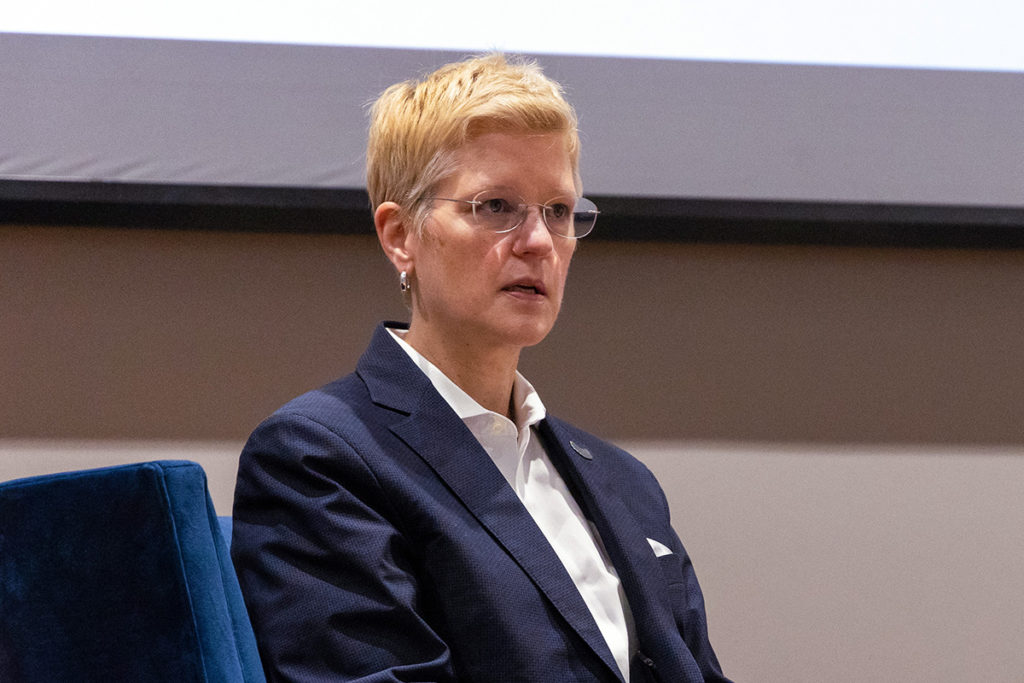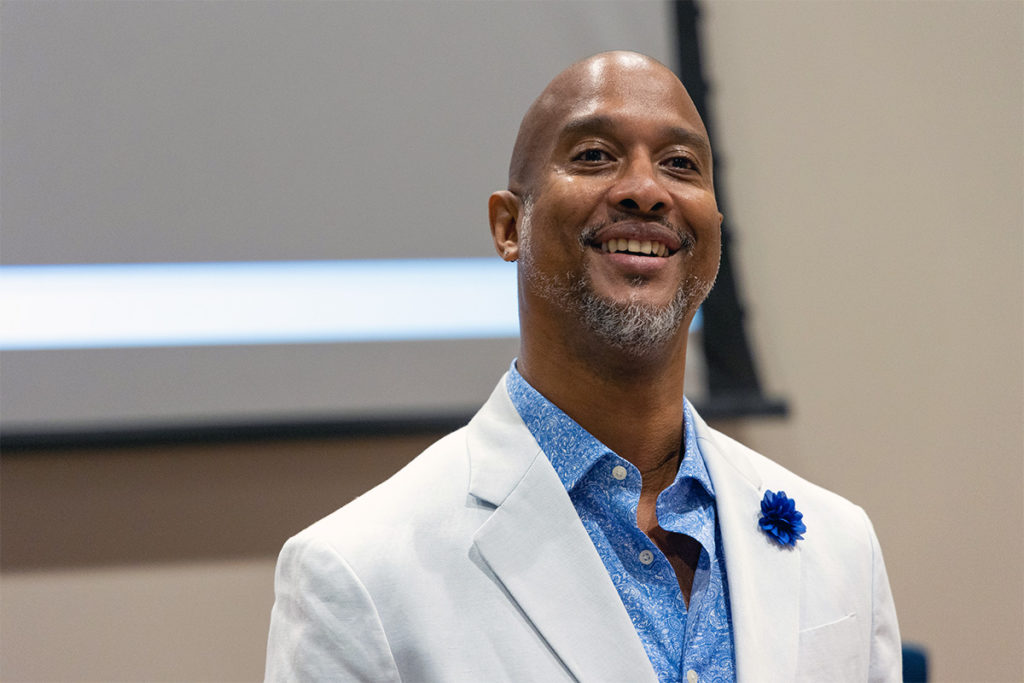BATON ROUGE, La.—In 1955, following the murder of her 14-year-old son Emmett Till in Money, Miss., his mother Mamie Till Bradley sent a telegram to President Dwight D. Eisenhower. “I the mother of Emmett Louis Till still am pleading that you personally see that justice is meted out to all persons involved in the beastly lynching of my son in Money, Miss. Awaiting a direct reply from you,” the telegram reads.
Eisenhower never responded. In the years that followed, the Federal Bureau of Investigation declined to prosecute any of the confirmed or suspected murderers of Till, even after Roy Bryant and J.W. Milam confessed to the lynching in a heavily fictionalized, selective retelling of the killing in Look magazine in 1956.
The FBI’s failure to meaningfully act went beyond prosecution, however. Former FBI agent Dale Killinger was the lead investigator in the bureau’s 2004 investigation of the crime. After a screening of documentarian Keith Beauchamp’s “The Untold Story of Emmett Louis Till” at Southern University on June 20, 2022, Killinger acknowledged that the FBI had never even investigated the lynching of Emmett Till at all prior to 2004.
“We didn’t investigate the murder and kidnapping of Emmett Till,” Killinger said during question-and-answer period after the screening. “We investigated the threatening letters to (Tallahatchie County Sheriff Clarence Strider), to Carolyn Bryant and to the defense and prosecution, but we did not investigate the actual murder. We did try to find (Henry Lee Loggins) and (Levi “Too Tight” Collins), who were allegedly hidden in jail at one point. But we never investigated the actual kidnapping and murder until 2004.”
Carolyn Bryant was then the wife of Roy Bryant, one of Till’s admitted murderers. She encountered Till at their grocery store in Money before his abduction and murder, and what passed between them, Bryant and Milam explained later, motivated them to act. Loggins and Collins were two Black men alleged to have been involved with Till’s abduction and possibly his murder.
The Limits of FBI Authority
The FBI’s authority to prosecute crimes, including violence and murders, is limited. Former FBI agent Cynthia Deitle was also present at the screening, and joined the discussion that followed. Deitle, who led the bureau’s Cold Case Initiative from 2008 to 2011 as chief of the civil rights unit, explained that the agency had three statutes available to prosecute cold cases.
“One was kidnapping across state lines, one was murder on federal land, and one was use of an explosive device,” Deitle explained.
None of the three applied to Till’s murder. The U.S. Department of Justice used the federal kidnapping statute to successfully prosecute James Ford Seale for his lead role in the abduction—and subsequent murders—of Henry Dee and Charles Moore in 1964. That federal strategy worked in Seale’s 2007 federal trial in Jackson because the Ku Klux Klan members drove the two young men through Louisiana before dumping their bodies into an offshoot of the Mississippi River. That trial resulted from a collaborative investigation between the Jackson Free Press and the Canadian Broadcasting Corp. starting with the 2006 discovery that Seale was still live. FBI documents the team obtained then showed that, unbeknownst to the families of the victims, the bureau had, indeed, investigated the murders and turned extensive evidence over to local prosecutors, who refused to pursue a case against them.
But Roy Bryant, J.W. Milam and accomplices did not transport Till across state lines, kill him on federal land or use explosives, choosing other ways to torture him.
Still, a fourth federal legal option may well have worked, Deitle added, had there been the will to try it then.
“The one statute that we could have used was a conspiracy statute that was passed in 1948 under federal law. It was a federal conspiracy statute (against) two or more people conspiring to violate someone’s civil rights,” Deitle said.

“We tried that in the ‘Mississippi Burning’ case: the murders of (Michael Schwerner, James Chaney, and Andrew Goodman). We used that statute amongst others to prosecute those perpetrators, and the Supreme Court upheld it.” That successful use of the federal conspiracy statute sent seven of 18 members of the Neshoba County lynch mob to federal prison in 1967 for short prison sentences but not Klan lynch-mob organizer Edgar Ray Killen because jurors did not want to convict a preacher. The State of Mississippi did successfully prosecute Killen in 2005 on manslaughter charges, sending him away for 60 years. He died in prison in 2018, as Seale did in 2011 after living free for decades after the 1960s murders.
Under federal statute, key to the use of the conspiracy law, however, was what right was violated. In the case of Goodman, Chaney and Schwerner, prosecutors held that the murderers infringed upon their freedom to travel across state lines. Two of them were from New York, and Chaney grew up and lived in Meridian.
“So the Supreme Court said you had the right to go from one state to another without fear of being beaten or murdered,” Deitle said. In truth, she added, the winds had changed politically. “Had the federal government had the appetite in 1955 to do what they did in the 1960s, maybe it would’ve worked then.”
One audience member at Southern University, an HBCU in Baton Rouge, pointed out that Bryant, Milam and the others involved gravely violated Till’s First Amendment Rights: his right to speech. After all, Till’s kidnapping and murder resulted from comments he allegedly made to one of the murderers’ wives, Carolyn Bryant.
‘No Investigation File Exists’
But in spite of the legal maneuvering necessary for a federal prosecution, nothing barred the FBI from investigating the kidnapping and murder in 1955, much as they did less than 10 years later in the murders of Dee and Moore and other cases of race violence. Without the effort or willpower at the time of Till’s murder, it was left to local and national activists—NAACP investigators, including Medgar Evers and Amzie Moore, to seek out eyewitness accounts.
Decades later, it would take even more effort to stir the FBI into action.
In 2005, documentarian Keith Beauchamp, a native of Louisiana, released the landmark film “The Untold Story of Emmett Till,” replete with primary source interviews with many of Emmett Till’s family and friends, including his mother Mamie Till herself. In researching Till’s murder, Beauchamp uncovered numerous allegations that several other men—not just Bryant and Milam—assisted in the kidnapping and lynching of Till. Some were Black.
In addition, Beauchamp uncovered the existence of an outstanding warrant against Carolyn Bryant. The information, presented before the film’s release, spurred the FBI into a new attempt at prosecuting Bryant, then nearly 80, that led to a 2007 Leflore County grand jury declining to indict her or any other suspect for the murder.

“Keith was able to present the things you saw in the film today as building blocks for why there ought to be an investigation,” former FBI investigator Killinger said. “And that led to the district attorney saying, ‘if the FBI investigates it, I’ll prosecute it.’ So essentially the FBI investigation in 2004 was really just us doing it for the state prosecutor.”
When Killinger began his investigation of the kidnapping and murder of Emmett Till, years of complete inaction on the part of the FBI meant that he was starting virtually from scratch.
“In 2004, no investigation file exists,” Killinger explained. “No physical evidence exists. We didn’t have the right murder site. Keith had the right farm in his film, but he was off by a barn. One barn to the left is the proper murder site. The sheriffs, judges, jurors, prosecuting attorneys and all the defense attorneys except one were dead.”
“We knew there was a trial transcript, but we didn’t know where it was at, he continued in Baton Rouge. “Since the 1960s we knew that there was no actual, true autopsy performed on Till. There was a doctor who looked at the body—very biased, if you read the court transcript,” Killinger continued.
The FBI’s ignorance about Till’s kidnapping and ignorance was apparent when the first real investigation began in 2001. “The body that’s in the grave in Chicago? We didn’t know for sure if it’s really Emmett Till,” Killinger said. “Culturally and factually, the country was still divided about some of those facts. The story that Milam and Bryant sold in 1956 was still the story a lot of people believed.”
A 2005 autopsy exhaustively proved that Emmett Till was the body pulled from the Tallahatchie River and buried in Chicago. Interviews with Carolyn Bryant, who is still alive today, included strange admissions contradicting her earlier testimony about the night of Till’s murder. Carolyn Roy Bryant’s wife admitted to Killinger in 2005 that she remembered Roy Bryant, Milam and a friend named Elmer Kimbell bringing Emmett Till to their house, supposedly unharmed.
“She doesn’t talk long about it,” Killinger said. “But what she says is ‘I couldn’t have identified him,’ something to that effect—when in fact that was the whole purpose for them being there: for her to say ‘That’s the boy.’ So I got this kind of half confession from her. That he’s brought to her, but she won’t say ‘I identified him.’”
But in spite of the reams of new information, and Killinger’s illuminating interviews with Bryant, the grand jury declined to return an indictment for her. Killinger expressed his immense disappointment at the failure to secure an indictment.
What Comes Next
Today, Killinger said, the stark contrast between the FBI’s dogged pursuit of the Lindbergh baby and their near paralyzed inaction after the lynching of Emmett Till is presented to agents in training.
“It’s used at the FBI academy to teach new agents: they compare and contrast the (investigation of the) Lindbergh kidnapping … a white baby which was before Till, versus the response for Till.”
Filmmaker and Till family advocate Beauchamp does not mince words on what he believes should come next: a serious effort to prosecute the woman who set off the chain of events that resulted in the the murder of Emmett Till. Carolyn Bryant Donham, who later remarried, is now 88 and believed to be living in North Carolina.
“The next step is to go after Carolyn,” Beauchamp said. “She needs to be held accountable for her participation in kidnapping and murder. I believe that she should be charged under culpable manslaughter. She had to understand the danger that Emmett Till would be in, and did nothing to stop it.”
Editor’s note: Keith Beauchamp is on the advisory board of the Mississippi Free Press. He was not consulted about the content of this piece nor did he review it before publication.





